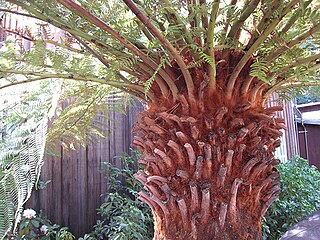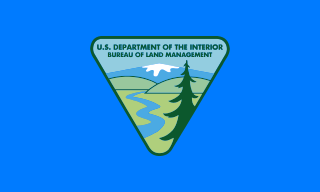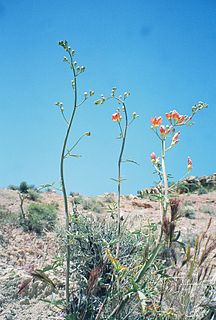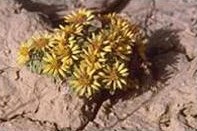| Schoenocrambe barnebyi | |
|---|---|
 | |
| Scientific classification | |
| Kingdom: | Plantae |
| (unranked): | Angiosperms |
| (unranked): | Eudicots |
| (unranked): | Rosids |
| Order: | Brassicales |
| Family: | Brassicaceae |
| Genus: | Schoenocrambe |
| Species: | S. barnebyi |
| Binomial name | |
| Schoenocrambe barnebyi (S.L.Welsh & N.D.Atwood) Rollins | |
| Synonyms | |
Hesperidanthus argillaceus | |
Schoenocrambe barnebyi (syn. Hesperidanthus barnebyi) is a rare species of flowering plant in the mustard family known by the common names Barneby reed-mustard, Syes Butte plainsmustard, and Barneby thelypody. It is endemic to Utah in the United States, where it is known only from Emery and Wayne Counties. [1] It is threatened by habitat degradation and destruction. It is federally listed as an endangered species of the United States.
In scientific nomenclature, a synonym is a scientific name that applies to a taxon that (now) goes by a different scientific name, although the term is used somewhat differently in the zoological code of nomenclature. For example, Linnaeus was the first to give a scientific name to the Norway spruce, which he called Pinus abies. This name is no longer in use: it is now a synonym of the current scientific name, Picea abies.

Brassicaceae or Cruciferae is a medium-sized and economically important family of flowering plants commonly known as the mustards, the crucifers, or the cabbage family. Most are herbaceous plants, some shrubs, with simple, although sometimes deeply incised, alternatingly set leaves without stipules or in leaf rosettes, with terminal inflorescences without bracts, containing flowers with four free sepals, four free alternating petals, two short and four longer free stamens, and a fruit with seeds in rows, divided by a thin wall.

Endemism is the ecological state of a species being unique to a defined geographic location, such as an island, nation, country or other defined zone, or habitat type; organisms that are indigenous to a place are not endemic to it if they are also found elsewhere. The extreme opposite of endemism is cosmopolitan distribution. An alternative term for a species that is endemic is precinctive, which applies to species that are restricted to a defined geographical area.
This is a perennial herb with multiple erect stems growing 10 to 38 centimeters tall from a caudex. The leaves are oblong or oval in shape with smooth or slightly toothed edges, the blades measuring up to 5 centimeters in length. The inflorescence is a raceme of mustardlike flowers. Each flower has green or purple sepals and four white or pale purple petals with purple veining, each petal measuring about a centimeter long. The fruit is a curved silique roughly 2 to 5 centimeters long. [2]

A caudex of a plant is a stem, but the term is also used to mean a rootstock and particularly a basal stem structure from which new growth arises.

An inflorescence is a group or cluster of flowers arranged on a stem that is composed of a main branch or a complicated arrangement of branches. Morphologically, it is the modified part of the shoot of seed plants where flowers are formed. The modifications can involve the length and the nature of the internodes and the phyllotaxis, as well as variations in the proportions, compressions, swellings, adnations, connations and reduction of main and secondary axes. Inflorescence can also be defined as the reproductive portion of a plant that bears a cluster of flowers in a specific pattern.
A raceme is an unbranched, indeterminate type of inflorescence bearing pedicellate flowers along its axis. In botany, an axis means a shoot, in this case one bearing the flowers. In indeterminate inflorescence-like racemes, the oldest flowers are borne towards the base and new flowers are produced as the shoot grows, with no predetermined growth limit. A plant that flowers on a showy raceme may have this reflected in its scientific name, e.g. Cimicifuga racemosa. A compound raceme, also called a panicle, has a branching main axis. Examples of racemes occur on mustard and radish plants.
This mustard grows in the San Rafael Swell on Bureau of Land Management territory in Emery County. The only other population is located in Capitol Reef National Park in Wayne County. The habitat is dry and mostly barren of vegetation. The substrate is fine, eroding red clay containing large amounts of selenium and gypsum. The area is a desert shrub plant community. Other plants in the habitat include sweet sand verbena (Abronia fragrans), shadscale (Atriplex confertifolia), Utah serviceberry (Amelanchier utahensis), tarragon (Artemisia dracunculus), rubber rabbitbrush (Chrysothamnus nauseosus), Torrey's jointfir (Ephedra torreyana), green ephedra (Ephedra viridis), fluffgrass (Erioneuron pulchellum), Nuttall's povertyweed (Monolepis nuttalliana), dropseed grasses (Sporobolus) sp., and desert princesplume (Stanleya pinnata). [1]

The San Rafael Swell is a large geologic feature located in south-central Utah about 30 miles (48 km) west of Green River, Utah. The San Rafael Swell, measuring approximately 75 by 40 miles, consists of a giant dome-shaped anticline of sandstone, shale, and limestone that was pushed up during the Paleocene Laramide Orogeny 60-40 million years ago. Since that time, infrequent but powerful flash floods have eroded the sedimentary rocks into numerous valleys, canyons, gorges, mesas, and buttes. The swell is part of the Colorado Plateau physiographic region.

The Bureau of Land Management (BLM) is an agency within the United States Department of the Interior that administers more than 247.3 million acres (1,001,000 km2) of public lands in the United States which constitutes one-eighth of the landmass of the country. President Harry S. Truman created the BLM in 1946 by combining two existing agencies: the General Land Office and the Grazing Service. The agency manages the federal government's nearly 700 million acres (2,800,000 km2) of subsurface mineral estate located beneath federal, state and private lands severed from their surface rights by the Homestead Act of 1862. Most BLM public lands are located in these 12 western states: Alaska, Arizona, California, Colorado, Idaho, Montana, Nevada, New Mexico, Oregon, Utah, Washington and Wyoming.

Capitol Reef National Park is an American national park located in south-central Utah. The park is approximately 60 miles (97 km) long on its north–south axis but an average of just 6 miles (9.7 km) wide. The park was established in 1971 to preserve 241,904 acres of desert landscape and is open all year with May through September being the highest visitation months.
There are 2000 [3] to 3000 individuals of this plant remaining, but there may be more on nearby rugged terrain that is hard to explore. [1] This mustard is threatened by uranium mining at the San Rafael Swell location. While most of the mines are now inactive, they are still maintained and there is a road running right through the population. The other population experiences trampling damage from hikers. [1]

Uranium mining is the process of extraction of uranium ore from the ground. The worldwide production of uranium in 2015 amounted to 60,496 tonnes. Kazakhstan, Canada, and Australia are the top three producers and together account for 70% of world uranium production. Other important uranium producing countries in excess of 1,000 tons per year are Niger, Russia, Namibia, Uzbekistan, China, the United States and Ukraine. Uranium from mining is used almost entirely as fuel for nuclear power plants.











